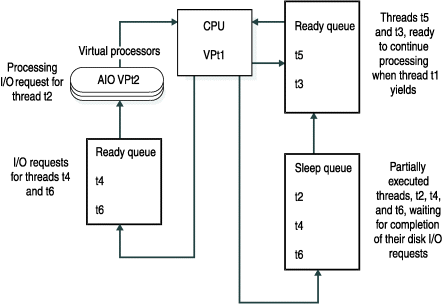
The database server uses three types of queues to schedule the processing of multiple, concurrently running threads:
Virtual processors of the same class share queues. This fact, in part, enables a thread to migrate from one virtual processor in a class to another when necessary.
Ready queues hold threads that are ready to run when the current (running) thread yields. When a thread yields, the virtual processor picks the next thread with the appropriate priority from the ready queue. Within the queue, the virtual processor processes threads that have the same priority on a first-in-first-out (FIFO) basis.
On a multiprocessor computer, if you notice that threads are accumulating in the ready queue for a class of virtual processors (indicating that work is accumulating faster than the virtual processor can process it), you can start additional virtual processors of that class to distribute the processing load. For information on how to monitor the ready queues, refer to Monitoring Virtual Processors. For information on how to add virtual processors while the database server is in online mode, refer to Adding Virtual Processors in Online Mode.
Sleep queues hold the contexts of threads that have no work to do at a particular time. A thread is put to sleep either for a specified period of time or forever.
The administration class (ADM) of virtual processors runs the system timer and special utility threads. Virtual processors in this class are created and run automatically. No configuration parameters impact this class of virtual processors.
The ADM virtual processor wakes up threads that have slept for the specified time. A thread that runs in the ADM virtual processor checks on sleeping threads at one-second intervals. If a sleeping thread has slept for its specified time, the ADM virtual processor moves it into the appropriate ready queue. A thread that is sleeping for a specified time can also be explicitly awakened by another thread.
A thread that is sleeping forever is awakened when it has more work to do. For example, when a thread that is running on a CPU virtual processor needs to access a disk, it issues an I/O request, places itself in a sleep queue for the CPU virtual processor, and yields. When the I/O thread notifies the CPU virtual processor that the I/O is complete, the CPU virtual processor schedules the original thread to continue processing by moving it from the sleep queue to a ready queue. Figure 26 illustrates how the database server threads are queued to perform database I/O.

Wait queues hold threads that need to wait for a particular event before they can continue to run. For example, wait queues coordinate access to shared data by threads. When a user thread tries to acquire the logical-log latch but finds that the latch is held by another user, the thread that was denied access puts itself in the logical-log wait queue. When the thread that owns the lock is ready to release the latch, it checks for waiting threads and, if threads are waiting, it wakes up the next thread in the wait queue.
Home | [ Top of Page | Previous Page | Next Page | Contents | Index ]